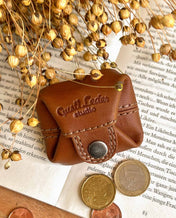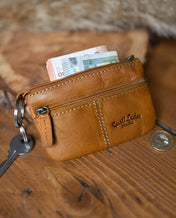Drying General
There are many important factors to consider during drying, such as time. Shorter drying times increase energy costs, while drying times that are too long can require too much time, which the tannery doesn't have. Since leather is usually sold by size or area, the drying method must also be considered. Using the wrong drying method can damage the leather. Hides are dried a maximum of two times in the tannery: by air drying, high-frequency drying, pasting drying, vacuum drying, hanging drying, nailing, or stretching.

Air drying
Air-drying is very labor-intensive, but also inexpensive, as the hides are placed flesh-side up on the ground in light sunlight or stretched in a tenter frame. This method reduces hide shrinkage.
This method was already practiced by Native Americans for leather production. Ropes are woven through holes in the edge of the hides.

Wilting
During the wilting process, the freshly dyed hides are pulled through a wilting machine. This machine is lined with felt on the inside to prevent damage to the hide. This process squeezes out approximately 35%-50% of the moisture. This saves considerable time and effort during the subsequent drying process.

High-frequency drying
This method allows the water content to be reduced to a desired level. The mechanically pre-dewatered (wilted) leather is conveyed into a high-frequency field via a belt conveyor system. This heats the leather and evaporates the water. Because the energy required is very high and electromagnetic systems are often subject to interference, this method is rarely used.

Pasting drying
Pasting drying is also called adhesive drying because the hides are primarily glued grain-side down to glass plates. Starch or a cellulose product, for example, is applied as an adhesive. This dissolves easily in water and does not penetrate deeply into the leather. Gluing the hide creates tension, preventing it from shrinking during drying and potentially increasing the surface area. The glass plates with the glued hides are then placed in a drying tunnel with controlled temperature and air circulation. This dries the leather in just a few hours. This saves time during drying, and the tension makes the leather smooth. Unfortunately, the residual adhesive is a major disadvantage and must be taken into account during further processing, which is why not all types of leather can be used for this drying method.

Vacuum drying
With this drying method, the water evaporates at low pressure and temperature, thus requiring less heat and time. The hides are placed in a vacuum dryer with the grain side facing heated metal surfaces. This causes the liquid to flow to the meat side, and the remaining fats are absorbed from the grain side into the hide. Furthermore, the labor required is much less, as the hides are held to the metal plate without glue or staples.

Hanging drying
The hides are dried as flat and freely as possible, hanging from hooks or over rods at normal room temperature with possibly increased air circulation. This method is particularly suitable for thin hides, as drying takes a very long time. Hanging causes the leather to deform the most.

Nailing or clamping
In this method, the hides are secured to a perforated metal plate or wooden rack with nails or staples. This creates a smooth leather, allowing water to evaporate from the grain and flesh sides. The leather dries for 8-10 hours at 50-60°C.

Additional sources (accessed 22.01.2019):
- leder-info(dot)de/index.php/Trocknen
- lederpedia(dot)de/leatherproduction/drying/drying
- softart-leder-shop(dot)de/btc/leder-lexikon/begriff/trocknen






